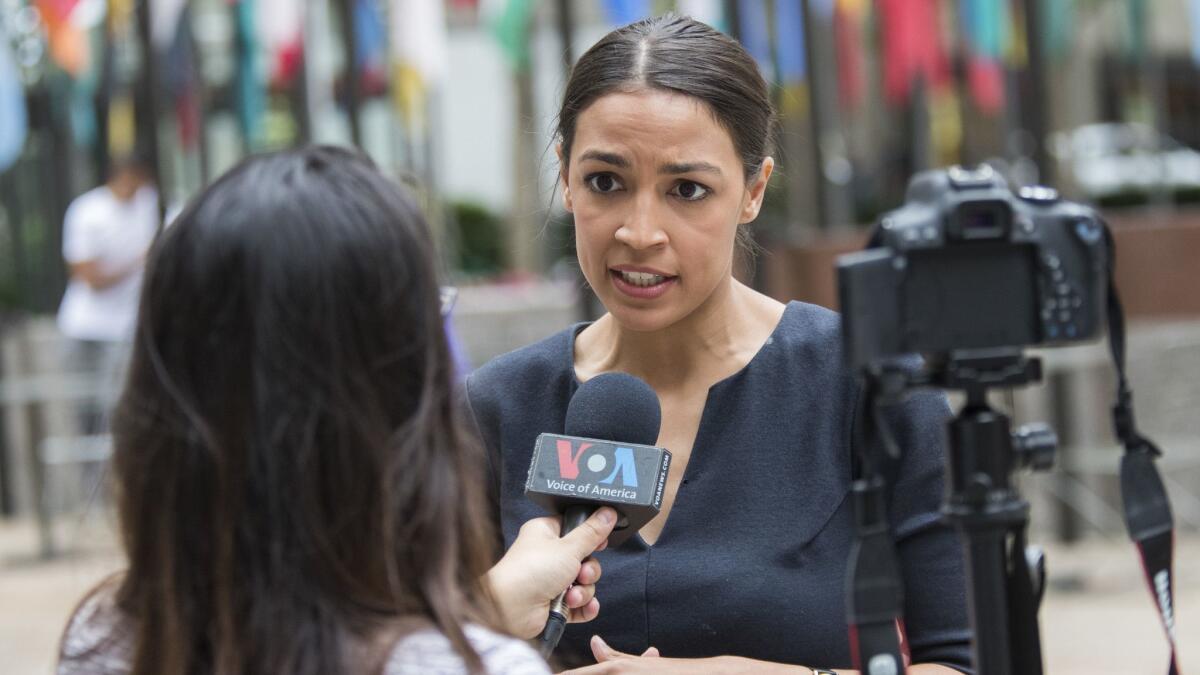Op-Ed: Americans like socialism now

- Share via
American socialism is having one hot summer. In New York, 28-year-old Alexandria Ocasio-Cortez, running as a Democratic Socialist, upset Rep. Joe Crowley, favored to succeed Rep. Nancy Pelosi as leader of the House Democrats, in the Democratic primary. Democratic gubernatorial candidate Cynthia Nixon, running in the September primary against Gov. Andrew Cuomo, has proclaimed herself a Democratic Socialist too.
Its numbers surging in the wake of Ocasio-Cortez’s stunning victory, the Democratic Socialists of America now claims 45,000 members. That’s a nine-fold increase over the 5,000 members (myself included) it had before Vermont Sen. Bernie Sanders began his presidential run in 2015.
Connected to but distinct from the socialist surge, leading Democrats, not just from the party’s left but from its center as well — particularly if they have presidential aspirations — are embracing social Democratic policies. Massachusetts Sen. Elizabeth Warren has co-sponsored Sanders’ bill to supplant our unaffordable hodgepodge of a healthcare system with Medicare for all; so have her previously centrist colleagues, New Jersey’s Cory Booker and New York’s Kirsten Gillibrand, who also have endorsed Sanders’ proposal for a governmental full-employment program. Of the 57 Democrats who have won congressional primaries in swing districts and will challenge Republican incumbents this November, according to the Progressive Change Campaign Committee, 33 support Medicare for all.
By running in Democratic primaries, candidates like Sanders and Ocasio-Cortez have made it easy for progressives...to vote for them.
The rising fortunes of the American socialist movement have invariably coincided with the leftward shifts of mainstream liberalism. The high point of early 20th century socialism came in 1912, when Socialist Party presidential candidate Eugene Debs won 6% of the general election vote, even as two reformist liberals — Democrat Woodrow Wilson and progressive Theodore Roosevelt — won 69% of the vote between them. The next period of socialist ascent, the 1930s, arose in tandem with the New Deal.
The dysfunctions inherent in capitalism don’t seem to lead, as Karl Marx said they would, to socialist revolutions, but when they get bad enough, they certainly lay the groundwork for periods of socialist upsurge. Just as Gilded Age plutocracy produced both Debsian socialism and Progressive Era reform, just as the Depression made possible the epochal changes of the New Deal, so the 2008 crash and the subsequent recovery, which has seen nearly all newly created wealth claimed by the 1% while wages stagnate, has led to a rebirth of the American left.
Indeed, Sanders’ presidential campaign didn’t so much create a new left as reveal it. Before Sanders had garnered a single vote, polls on the eve of the Iowa caucuses and the New Hampshire primary showed that 43% of likely voters in the former and 31% in the latter said they were socialists. The shift to socialism has been particularly pronounced among the young, for whom the job security, debt-free college educations and affordable housing that their parents and grandparents could count on no longer exist. A 2017 YouGov poll asked millennials whether they preferred to live in a capitalist, socialist, fascist or communist nation. While 42% said capitalist, 44% said socialist — a breathtaking response in a nation long deemed exceptional by the absence of a socialist movement.
Enter the Fray: First takes on the news of the minute from L.A. Times Opinion »
The new birth of American socialism derives in part from a shift in electoral strategy dating to the 1970s. Michael Harrington, the Democratic Socialists of America founder, argued that given the nation’s entrenched two-party system, the most advantageous way to present socialism to voters was to have openly socialist candidates run as Democrats. Running on a third-party line, socialists were likely only to siphon support from Democrats and help elect Republicans, as the independent candidate Ralph Nader was to do, calamitously, in the 2000 presidential contest.
By running in Democratic primaries, candidates like Sanders and Ocasio-Cortez have made it easy for progressives, who would have shunned them had they run as Nader-esque spoilers, to vote for them and, in some cases, to join DSA.
It took more than 40 years in the political desert, however, until Harrington’s strategy was so decisively vindicated — 40 years in which the economy grew steadily harsher. In the 1970s and ’80s, the constraints that unions and New Deal legislation had placed on corporate conduct had yet to fully erode. During that time, the Los Angeles DSA chapter, in which I was active, never had more than roughly 350 members (one of them a spy from the Ed Davis-Daryl Gates-era Los Angeles Police Department). Today, the L.A. chapter has close to 1,500 members, campaigning for rent control, for shuttering ICE, for single-payer health insurance. Most are millennials, who need no instruction in how our economic system curtails prosperity and breeds plutocracy.
Socialism is back. If you seek a culprit, blame capitalism.
Harold Meyerson is executive editor of the American Prospect. He is a contributing writer to Opinion.
Follow the Opinion section on Twitter @latimesopinion or Facebook
More to Read
A cure for the common opinion
Get thought-provoking perspectives with our weekly newsletter.
You may occasionally receive promotional content from the Los Angeles Times.









